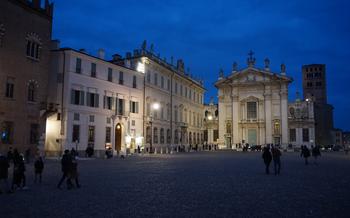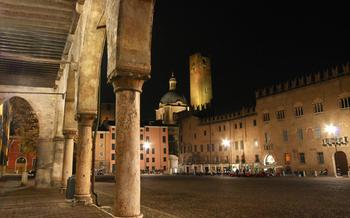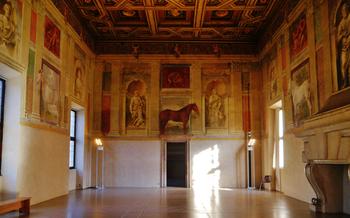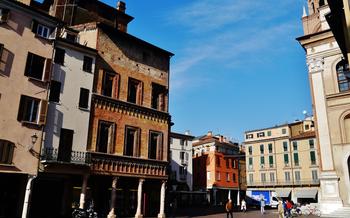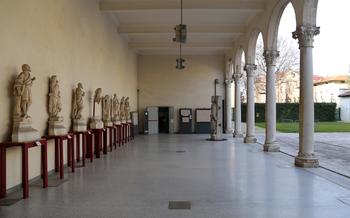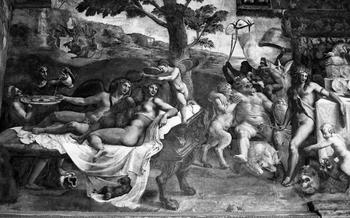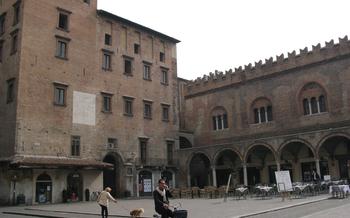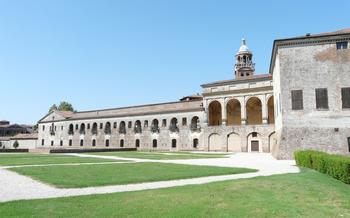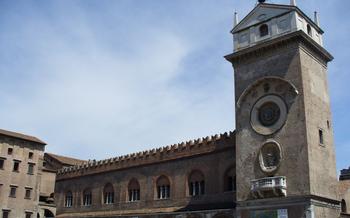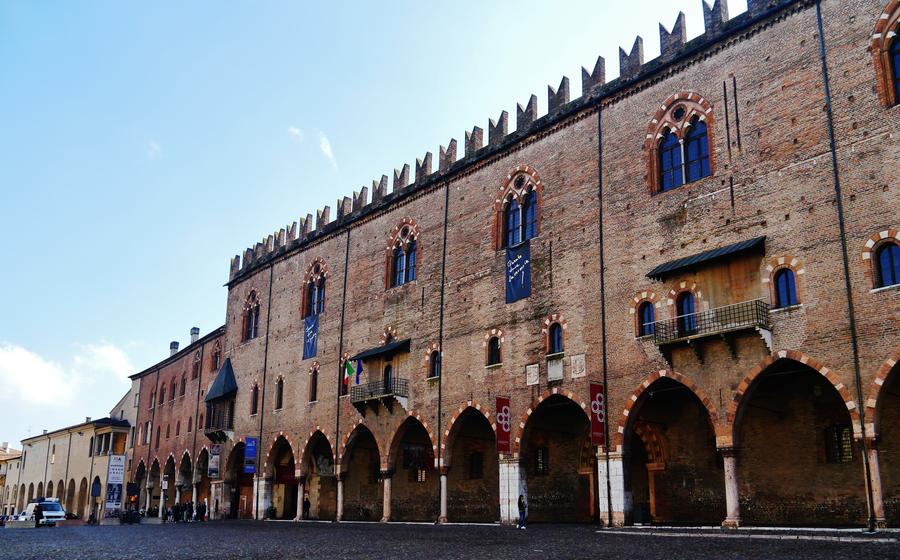
Ducal Palace
- Introduction - The Allure of Mantua's Ducal Palace
- Navigating the Ducal Palace - A Journey Through History
- Exploring the Courtyard of Honor - An Enchanting Oasis
- Discovering the Hall of Mirrors - A Regal Reflection
- Unveiling the Gonzaga Family's Legacy
- Exploring the Ducal Gardens - A Tranquil Escape
- Marveling at the Palazzo Te - A Renaissance Retreat
- Stepping Back in Time at the Palazzo Ducale Museum
- Discovering Mantua's Enchanting Old Town
- Savoring Mantua's Culinary Delights
- Unveiling Mantua's Artistic Treasures
- Attending Events and Festivals in Mantua
- Planning Your Visit to Mantua
- Insider Tip - Unveiling the Secret Passage
Introduction - The Allure of Mantua's Ducal Palace
In the heart of Mantua, a city steeped in history and culture, stands the majestic Ducal Palace, a testament to the grandeur of the Gonzaga dynasty that once ruled this enchanting land. Immerse yourself in the allure of this architectural masterpiece, a true embodiment of Renaissance splendor. Prepare to be captivated by its breathtaking artwork, intricate frescoes, and the poignant stories of the Gonzaga family that echo within its walls. Step into the Ducal Palace and embark on an immersive journey through time, where history, art, and culture intertwine to create an unforgettable experience.
Navigating the Ducal Palace - A Journey Through History
To fully immerse yourself in the grandeur of the Ducal Palace, careful planning is essential. Begin your journey by selecting the best time to visit. While the palace's timeless beauty remains constant, specific seasons and times of day can enhance your experience. Consider the summer months for extended opening hours and the chance to explore the palace's gardens in full bloom. Alternatively, the quieter autumn and winter seasons offer a more intimate and serene atmosphere.
Once you've chosen your ideal time, consider the various ways to explore the palace. Guided tours are an excellent option for those seeking a comprehensive understanding of the palace's history and secrets. Led by knowledgeable guides, these tours delve into the details of the palace's architecture, artwork, and the stories of the Gonzaga family. For a more independent experience, opt for self-exploration. Equipped with a map or audio guide, you can wander at your own pace, discovering hidden corners and details that capture your curiosity.
To make the most of your visit, plan a route that aligns with your interests. Start with the iconic Camera degli Sposi, home to Mantegna's masterpiece, then explore the Courtyard of Honor and Hall of Mirrors. Don't miss the opportunity to visit the Palazzo Ducale Museum, which houses a treasure trove of artifacts and documents that provide insights into the Gonzaga dynasty and their reign.
Remember, the Ducal Palace is a living testament to history, and its charm extends beyond its physical walls. Take a moment to step outside and explore the enchanting Old Town of Mantua. Wander through picturesque piazzas, marvel at medieval and Renaissance architecture, and indulge in the local culinary delights that reflect the city's rich heritage.
Exploring the Courtyard of Honor - An Enchanting Oasis
As you step into the Courtyard of Honor, prepare to be captivated by the harmonious blend of Renaissance architecture and serene natural beauty. This enchanting oasis, designed by Luca Fancelli in the 15th century, serves as the heart of the Ducal Palace.
Surrounded by elegant arcades and graceful loggias, the courtyard exudes an atmosphere of tranquility and grandeur. Admire the intricate carvings and delicate frescoes that adorn the walls, each narrating a tale from the Gonzaga family's illustrious past.
In the center of the courtyard, a serene garden invites you to pause and soak in the tranquility. Stroll amidst manicured lawns, colorful flower beds, and ancient trees, creating a picturesque backdrop for your visit.
Don't miss the hidden gems tucked away within the courtyard. Discover exquisite sculptures nestled in corners, each masterpiece a testament to the artistic patronage of the Gonzagas. As you wander through the loggias, take a moment to appreciate the stunning views of the palace's exterior and the surrounding cityscape.
The Courtyard of Honor is not just a passageway but an enchanting destination in itself. Allow yourself to be transported back in time as you explore this serene oasis, a true testament to the grandeur and artistry of the Renaissance era.
Discovering the Hall of Mirrors - A Regal Reflection
Step into the Hall of Mirrors, a testament to opulence and grandeur. Prepare to be captivated by the intricate interplay of reflections and light, creating an enchanting ambiance that will transport you to a bygone era. Marvel at the walls adorned with countless mirrors, each reflecting the room's elegant furnishings and the shimmering crystal chandeliers that hang overhead.
The Hall of Mirrors served as a grand ballroom, hosting lavish parties and celebrations that showcased the wealth and power of the Gonzaga family. Imagine the scene as nobles and dignitaries danced beneath the soft glow of candlelight, their movements mirrored endlessly, creating a mesmerizing spectacle. The room's acoustics were also carefully crafted, ensuring that music and laughter reverberated throughout the space, adding to the festive atmosphere.
For those with a keen eye, hidden within the mirrors are intricate frescoes depicting scenes from mythology and allegory. These delicate works of art, often overlooked amidst the grandeur of the mirrors, offer a glimpse into the artistic sensibilities of the Gonzaga family and their passion for the Renaissance. Take a moment to pause and admire these hidden treasures, each telling a unique story that adds depth and character to this remarkable space.
Unveiling the Gonzaga Family's Legacy
The House of Gonzaga, a powerful and influential dynasty, ruled Mantua for over four centuries, leaving an indelible mark on the city's history and culture. Renowned for their patronage of the arts, the Gonzagas were instrumental in transforming Mantua into a thriving artistic and cultural center during the Renaissance.
Their reign witnessed the construction of magnificent palaces, churches, and public buildings, adorned with exquisite works of art commissioned by the Gonzaga family. They were ardent collectors of paintings, sculptures, and tapestries, amassing an impressive collection that reflected their refined taste and appreciation for beauty.
The Gonzaga family's legacy extends beyond the realm of art. They were astute patrons of literature, music, and theater, attracting renowned artists, scholars, and musicians to their court. Their patronage created a vibrant intellectual and cultural environment that made Mantua a sought-after destination for artists and intellectuals seeking inspiration and patronage.
Their political acumen and diplomatic skills enabled them to maintain Mantua's independence and prosperity during a tumultuous period of Italian history. Through their alliances and astute maneuvering, they navigated the complex political landscape of the time, ensuring Mantua's stability and growth.
The Gonzaga legacy is intricately interwoven with the fabric of Mantua's identity. Their patronage of the arts, their political achievements, and their cultural influence have left a lasting impression on the city, making it a treasure trove of Renaissance art and culture. To truly understand Mantua, one must delve into the captivating story of the Gonzaga family, whose vision and ambition shaped the city into the masterpiece it is today.
Exploring the Ducal Gardens - A Tranquil Escape
Beyond the magnificence of the Ducal Palace, visitors can find solace and tranquility in the enchanting Ducal Gardens. These verdant havens, meticulously sculpted by Renaissance artisans, offer a respite from the bustling city streets. Stroll through the serene landscapes, adorned with manicured lawns, vibrant flowerbeds, and towering trees that cast dappled shadows on the winding paths.
Uncover hidden fountains that playfully dance in the sunlight, each adorned with intricate carvings and sculptures that pay homage to the Gonzaga family. Admire the elegant statues that grace the gardens, whispering tales of ancient myths and legends. Discover picturesque viewpoints that unveil panoramic vistas of the city, with the iconic domes and towers of Mantua's skyline creating a breathtaking backdrop.
Immerse yourself in the tranquility of the Ducal Gardens, a sanctuary where nature and history intertwine. Allow the gentle rustle of leaves, the sweet fragrance of blooming flowers, and the melodious chirping of birds to transport you to a realm of serenity. Find a secluded bench beneath a shady tree and indulge in a moment of contemplation, surrounded by the beauty and tranquility of this enchanting oasis.
Marveling at the Palazzo Te - A Renaissance Retreat
Beyond the walls of the Ducal Palace, a short distance away, lies another architectural gem that is inextricably linked to the Gonzaga legacy: the Palazzo Te. This suburban retreat, commissioned by Federico II Gonzaga, stands as a testament to the dynasty's enduring influence and patronage of the arts. Designed by the renowned architect and artist Giulio Romano, the Palazzo Te is a masterpiece of Renaissance architecture and a showcase of Mannerist style.
Immerse yourself in the lavishly decorated rooms, adorned with intricate frescoes, stuccowork, and sculptures that narrate mythological tales and allegories. Admire the interplay of light and shadow, the vibrant colors, and the illusionistic effects that create a sense of depth and movement. The Palazzo Te is not merely a building; it is a work of art in its own right, a testament to the genius of Giulio Romano and the artistic legacy of the Gonzaga family.
Stroll through the verdant gardens that surround the palace, designed by Romano himself. Discover hidden fountains, sculptures, and picturesque vistas that blend seamlessly with the architectural masterpiece. The Palazzo Te is not just a palace; it is an oasis of tranquility, a place where art, nature, and history converge in perfect harmony.
Stepping Back in Time at the Palazzo Ducale Museum
Delve into the captivating history and stories behind the treasures housed within the Palazzo Ducale Museum, a treasure trove of knowledge and artifacts that bring the Gonzaga era to life. Explore a diverse collection of paintings, sculptures, tapestries, and other precious objects that narrate the rise and reign of this powerful dynasty. Discover personal belongings, official documents, and intriguing insights into the daily lives and political maneuvers of the Gonzaga family. Each exhibit tells a tale, shedding light on their patronage of the arts, their diplomatic prowess, and the cultural legacy they left behind. Immerse yourself in the grandeur and opulence of the Gonzaga court, gaining a deeper appreciation for their profound impact on Mantua and the broader Renaissance world.
Discovering Mantua's Enchanting Old Town
Beyond the awe-inspiring walls of the Ducal Palace, the city of Mantua unveils a treasure trove of historical and architectural wonders. Get lost in the labyrinthine alleys of the enchanting old town, where cobbled streets whisper tales of bygone eras. Admire the grandeur of medieval palazzos and churches, each adorned with intricate frescoes and sculptures that transport you back in time.
Stroll through the picturesque Piazza Sordello, the heart of the old town, and soak in the vibrant atmosphere. Marvel at the towering Palazzo del Podestà, a testament to Mantua's rich past, and climb the Torre della Gabbia for breathtaking panoramic views of the city.
Don't miss the Piazza delle Erbe, a bustling square once used as a marketplace. Here, you'll find the elegant Palazzo della Ragione, home to the city archives, and the Rotonda di San Lorenzo, a unique Romanesque church with a circular design.
As you wander, discover hidden gems tucked away in every corner. Visit the Palazzo d'Arco, with its stunning Renaissance frescoes, or the Teatro Bibiena, a masterpiece of Baroque architecture. Immerse yourself in the city's medieval and Renaissance heritage, and let Mantua's old town cast its spell upon you.
Savoring Mantua's Culinary Delights
Mantua's culinary scene is a testament to its rich history and cultural influences. Indulge in the local specialty, Tortelli di Zucca, a delicious pasta filled with a sweet and savory pumpkin filling, served with melted butter and sage. Sbrisolona, a traditional almond cake, is another must-try, known for its crumbly texture and nutty flavor. Mantuan cuisine reflects the city's unique position at the crossroads of different cultures, blending Italian, Austrian, and Jewish culinary traditions. From cozy trattorias to Michelin-starred restaurants, Mantua offers a culinary adventure for every palate. Don't miss the chance to savor the flavors of this enchanting city, where food is an integral part of the cultural experience.
Unveiling Mantua's Artistic Treasures
Beyond the Ducal Palace, Mantua boasts a treasure trove of artistic wonders that beckon exploration. Admire the grandeur of the Palazzo della Ragione, a 13th-century palace adorned with a majestic clock tower. Step inside the Teatro Bibiena, a jewel of late Baroque architecture, with its enchanting horseshoe-shaped auditorium and intricate frescoes. For a spiritual immersion, visit the Basilica di Sant'Andrea, a masterpiece of Renaissance architecture, housing exquisite artwork, including Mantegna's renowned Deposition altarpiece. Discover the hidden gems tucked away in Mantua's churches, such as the stunning frescoes by Giulio Romano in the Cappella Ducale di San Sebastiano. Immerse yourself in the city's artistic legacy, where history, architecture, and creativity intertwine to create a captivating cultural experience.
Attending Events and Festivals in Mantua
Mantua's vibrant cultural scene is brought to life by an array of events and festivals that celebrate the city's rich history and traditions. These events offer a unique opportunity to immerse yourself in the local culture and connect with the community.
One of the most renowned events is the Festa di San Longino, held annually on November 15th. This religious festival honors the patron saint of Mantua and features a solemn procession through the city streets, accompanied by music, dancing, and traditional costumes.
Another highlight is the Settembre Mantovano, a month-long festival held in September. This cultural extravaganza showcases Mantua's artistic heritage with a variety of exhibitions, concerts, theater performances, and historical reenactments. Visitors can experience the city's piazzas transformed into vibrant stages, hosting live music, street theater, and traditional crafts demonstrations.
For music enthusiasts, the Mantua Jazz Festival in July offers a diverse lineup of local and international jazz musicians, performing in various venues across the city. Whether you prefer classical music or contemporary jazz, you'll find something to suit your taste.
If you're visiting Mantua in February, don't miss the Carnevale di Mantova, a lively carnival celebration filled with colorful parades, costume parties, and traditional masked balls. Join the locals in celebrating the end of winter and the arrival of spring with music, dancing, and plenty of laughter.
Attending events and festivals in Mantua is a fantastic way to experience the city's vibrant atmosphere and connect with its rich cultural heritage.
Planning Your Visit to Mantua
To fully immerse yourself in the charm of Mantua and experience the grandeur of the Ducal Palace, planning your visit is essential. Here are some practical tips to ensure a smooth and enjoyable trip:
-
Accommodation: Mantua offers a range of accommodation options to suit every budget and preference. From cozy guesthouses to elegant hotels, you'll find something to meet your needs.
-
Transportation: Mantua is well-connected by public transportation, making it easy to get around the city. Buses and trains provide convenient access to major attractions, including the Ducal Palace.
-
Budget Considerations: Plan your expenses wisely to make the most of your trip. Admission fees to the Ducal Palace and other attractions vary, so allocate a budget accordingly. Dining options range from affordable trattorias to fine-dining restaurants, offering something for every palate and budget.
-
Timing Your Visit: Mantua is a year-round destination, but the best time to visit is during the shoulder seasons (spring and autumn) when the weather is pleasant, and crowds are smaller. Summer months can be hot and crowded, while winters can be cold and damp.
-
Guided Tours: Consider joining a guided tour of the Ducal Palace to gain insights into its history, art, and architecture. Guided tours are available in various languages and provide an in-depth understanding of the palace's many wonders.
Insider Tip - Unveiling the Secret Passage
Amidst the magnificence of the Ducal Palace, a hidden gem awaits discovery - a secret passage that connects the palace to the Palazzo della Ragione, the city's medieval town hall. This subterranean corridor, concealed from the public eye, was once a strategic route used by the Gonzaga family to move discreetly between their residence and the seat of government.
To uncover this hidden treasure, visitors should venture to the appartamento vecchio, the oldest part of the palace. Here, tucked away behind a seemingly ordinary door, lies the entrance to the secret passage. Stepping through, one embarks on a journey through time, traversing narrow, dimly lit corridors with vaulted ceilings and ancient stone walls.
Emerging from the passage, visitors find themselves in the heart of the Palazzo della Ragione, surrounded by centuries-old frescoes and architectural wonders. This hidden connection between two of Mantua's most iconic landmarks offers a unique perspective on the city's rich history and the power dynamics of the Gonzaga dynasty.
